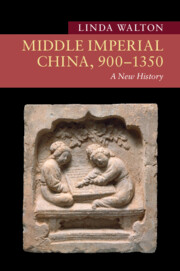Book contents
- Middle Imperial China, 900–1350
- New Approaches to Asian History
- Middle Imperial China, 900–1350
- Copyright page
- Dedication
- Contents
- Figures
- Maps
- Acknowledgments
- Introduction
- 1 The Turbulent Tenth Century
- 2 Song in a Multipolar World
- 3 Schooling, State, and Society in Song and Jin
- 4 An Economic Revolution?
- 5 Cities and Urban Life
- 6 Religious Transformations
- 7 Ways of Knowing
- 8 The Arts of Culture
- 9 Gendered and Generational Lives
- 10 Mapping the Built and Natural Environment
- 11 Sustaining Life and Healing Bodies
- 12 The Mongol Yuan Dynasty in China
- 13 Yuan China in the Mongol Eurasian Empire
- Bibliography
- Index
- New Approaches to Asian History
12 - The Mongol Yuan Dynasty in China
Published online by Cambridge University Press: 20 July 2023
- Middle Imperial China, 900–1350
- New Approaches to Asian History
- Middle Imperial China, 900–1350
- Copyright page
- Dedication
- Contents
- Figures
- Maps
- Acknowledgments
- Introduction
- 1 The Turbulent Tenth Century
- 2 Song in a Multipolar World
- 3 Schooling, State, and Society in Song and Jin
- 4 An Economic Revolution?
- 5 Cities and Urban Life
- 6 Religious Transformations
- 7 Ways of Knowing
- 8 The Arts of Culture
- 9 Gendered and Generational Lives
- 10 Mapping the Built and Natural Environment
- 11 Sustaining Life and Healing Bodies
- 12 The Mongol Yuan Dynasty in China
- 13 Yuan China in the Mongol Eurasian Empire
- Bibliography
- Index
- New Approaches to Asian History
Summary
One of the biggest questions in the study of China’s history is related to the impact of the Mongol conquest. The Mongols governed through multiple languages, and ruled ethnically and culturally distinct groups, in part through the adoption and adaptation of Chinese institutions. The reign of Qubilai Khan (1260–1294) laid the foundations of Mongol rule as the Yuan dynasty, establishing government administration that incorporated steppe patrimonialism emphasizing kinship and loyalty with Chinese bureaucracy. The Yuan capital, Dadu, the site of modern Beijing, was a planned political center that reflected the steppe origins of Mongol rulers as well as Chinese urban design. The Mongol conquest influenced artistic expression in a variety of ways, simultaneously continuing earlier traditions and introducing new ones. Both painters and poets left a rich legacy that can be used to reconstruct the multicultural and multiethnic world of Yuan cultural life. Regional differences mattered, especially the distinction between north and south following the loss of the north to the Jurchen in 1127. After the Mongol conquest, north and south were reunified, and Neo-Confucianism was adopted as orthodoxy by the Yuan government, clearly visible in the approved interpretations of the Classics for the examinations when they were restored in 1315.
- Type
- Chapter
- Information
- Middle Imperial China, 900–1350A New History, pp. 294 - 323Publisher: Cambridge University PressPrint publication year: 2023



